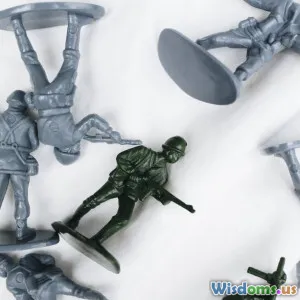
Escaping from Chains Analyzing Houdinis Greatest Challenge
9 min read Explore Houdini's groundbreaking escape artistry and his most perilous challenge: escaping from chains. (0 Reviews)
Escaping from Chains: Analyzing Houdini's Greatest Challenge
Harry Houdini, often hailed as the father of modern escapology, captivated audiences worldwide with feats that seemed to defy both logic and human limits. Among his many jaw-dropping stunts, his ability to escape from seemingly impregnable chains stands out as perhaps his greatest and most daring challenge. This article delves into the intricacies, history, and psychology behind Houdini’s chain escapes, shedding light on how he turned a simple act into an iconic symbol of magic and human endurance.
The Allure of the Impossible: Why Chains?
Chains symbolize restriction and confinement across cultures. They represent barriers—both physical and metaphorical—that inhibit freedom. For Houdini, chains were not just props; they were narrative devices that amplified tension and suspense. Audiences could instantly grasp the danger: heavy metal bindings could mean genuine injury or death if the escape failed.
But why chains explicitly? Unlike simple handcuffs or rope, chains coming with multiple padlocks suggested an even higher level of complexity and risk. The visual and tangible heft of linked steel conveyed a story of captivity that was primal and universal.
Houdini’s mastery lay in transforming this shared human experience—the desire for freedom—into palpable excitement. When he wriggled free from chains, he was not only beating physical constraints but also emotional ones attached to fear and desperation.
Historical Context: The Genesis of Chain Escapes
Before Houdini rose to fame, escape acts on stage were generally limited, often revolving around straightforward handcuffing or locked boxes. In the early 1900s, the theatrical landscape was ripe for innovation, and audiences were hungry for sensational spectacles. Houdini capitalized on this by escalating the stakes.
His earliest chain escapes can be traced to the late 1890s, when he started incorporating bursting out of trunks chained shut. With time, he introduced heavier chains and more padlocks, increasing the perceived and real difficulty exponentially.
One of the most famous examples was the "Milk Can Escape," debuting in 1908. In this illusion, Houdini was locked inside a giant, water-filled milk can sealed with heavy chains and locks. The intense pressure of time, deteriorating oxygen, and physical constraints made this a showstopper. It set precedents for chain-related escapes by combining elements of endurance, stealth, and timing.
The Mechanics Behind Houdini’s Chain Escapes
Contrary to popular legend, Houdini’s escapes were not purely a matter of “brute forcing” or hidden trickery unrelated to skill. They combined several important facets:
1. Lock Selection and Knowledge
Houdini was a skilled locksmith. He understood the inner mechanisms of padlocks and locks deeply, sometimes custom-selecting or modifying them to suit an act’s difficulty while knowing the vulnerabilities that might exist. This mastery allowed him to pick locks quickly under immense pressure—a hallmark of his performances.
2. Physical Conditioning and Flexibility
Many imagine Houdini as just a magician, but he was also a remarkable athlete. Wrestling and strength training were parts of his regimen, preparing his body for contortions, rapid extrication, and endurance required to struggle in confined environments.
3. Psychological Control
The ability to stay calm under tension is vital for escape artists. Houdini’s performances were as much about mental endurance as physical. The pressure of a packed auditorium, countdown clocks, and staged dangers could easily break concentration; Houdini’s focus was legendary.
4. Illusion and Misdirection
While Houdini prided himself on authentic escapes, he also understood theater. Slight manipulations—like hidden keys, slack in chains, or audience vantage points—were subtly employed but never undermined the real risk involved.
Iconic Chain Escapes: Moments That Cemented His Legacy
The Overboard Chain Escape
In one perilous stunt, Houdini was chained heavily and strapped with locks before being submerged into the East River. Bound with additional iron bars and sometimes immersed in water tanks, Houdini defied nearly certain drowning. The public's knowledge of these risks added a visceral sense of thrill. Newspapers at the time reported extensively on his narrow escapes and close calls, boosting his fame exponentially.
The Straitjacket and Chains
Although not strictly chains alone, Houdini’s ability to escape from a straightjacket fastened above the ground involved chains and shackles in various performances. The elevated element introduced serious danger—if he failed, a fall could cause injury, compounding the act's suspense.
Beyond Performance: Houdini’s Influence on Modern Escapology
Houdini revolutionized escapology by making the escape itself the dramatic centerpiece of his shows, rather than a setup for an unrelated illusion. His approach influenced generations of magicians and stunt performers who followed.
Contemporary escape artists, such as David Blaine and Criss Angel, owe much to Houdini's innovations. Moreover, his chain escapes inspired developments in stunt safety protocols and shaped public expectations about danger and authenticity in magic.
Psychological Impact on Audiences
The thrill generated by Houdini’s escapes stemmed from three core psychological triggers:
- Suspense: The visible imperilment and countdown to a possible tragedy.
- Empathy: A shared experience of confinement and the yearning for freedom.
- Wonder: The dissonance between expected physical limits and what Houdini achieved.
This powerful cocktail created a memorable and often transformative experience for spectators.
Conclusion: The Legacy of Houdini’s Chain Escapes
Harry Houdini’s chain escapes were more than dazzling spectacles; they were groundbreaking demonstrations of human skill, mind, and endurance against overwhelming odds. By mastering locks, chains, and the theater of danger, he elevated escapology from novelty to respected performance art.
His greatest challenge—escaping chains—remains an enduring symbol of tenacity and liberation. For magicians and audiences alike, Houdini’s feats are instructive on the power of combining discipline, ingenuity, and showmanship to break through barriers, literal and figurative.
As we study his legacy, we not only appreciate the mechanics behind the magic but also embrace the timeless message that true freedom is worth wrestling every chain to achieve.
References:
- Randi, James. Houdini: The Ultimate Escapologist. Boston: Da Capo Press, 1997.
- Von Taube, Thomas. "The Milk Can Escape and the Development of Escapology." Magic Magazine, 2011.
- Whalen, Rawland R. "Locksmithing and Magic: The Synergistic Skills of Houdini." Journal of Historical Escapology, 2018.
- Horn, John. "Psychology Behind Magic: How Houdini Captivated Hearts and Minds." Psychology Today, 2020.
Rate the Post
User Reviews
Popular Posts





















